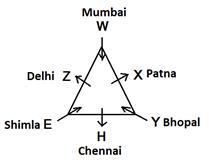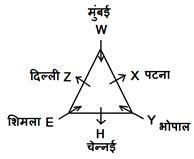
Dear Readers,
Mahendras has started special quizzes for IBPS & SBI Exam so that you can practice more and more to crack the examination. This IBPS & SBI Exam special quiz series will mold your preparations in the right direction and the regular practice of these quizzes will be really very helpful in scoring good marks in the Examination. Here we are providing you the important question of reasoning ability for the IBPS & SBI Exam.
Q.1-5. Study the following information carefully and answer the questions given below:
X, W, E, Y, H and J are sitting around a triangular table area at equal distances from their neighbours, but not necessarily in the same order. The number of people are facing the centre is same as the number of people are facing outside the centre. Three-person sits at three corners and one person sits at each of the three sides of the triangle. They belong to different city viz. Delhi, Shimla, Mumbai, Chennai, Patna and Bhopal, but not necessary in the same order.
The one who belongs to Bhopal is an immediate right of the one who belongs to Patna who is facing outside. Immediate neighbour of Z is facing the same direction. W is third to the right of H and belongs to Mumbai. X is an immediate right of Y and is not belongs to Chennai. E who belongs to Shimla and fifth to the right of Z. Z is not an immediate neighbour of H. The one who belongs to Bhopal is third to the left of the one who belongs to Delhi. Y is an immediate neighbour of the one who belongs to Chennai.
निम्नलिखित जानकारी का ध्यानपूर्वक अध्ययन करें और नीचे दिए गए प्रश्नों के उत्तर दें:
X, W, E, Y, H और J अपने पड़ोसियों से समान दूरी पर एक त्रिकोणीय मेज के चारों ओर बैठे हैं, लेकिन जरूरी नहीं कि इसी क्रम में हों। केंद्र की ओर देखने वाले व्यक्तियों की संख्या, केंद्र के बाहर देखने वाले व्यक्तियों की संख्या समान है। तीन व्यक्ति तीन कोनों पर बैठे हैं और एक व्यक्ति त्रिभुज के प्रत्येक भुजा के बीच में बैठे हैं। प्रत्येक व्यक्ति अलग-अलग शहर जैसे दिल्ली, शिमला, मुंबई, चेन्नई, पटना और भोपाल से है, लेकिन जरुरी नहीं कि इसी क्रम में हो।
जो व्यक्ति भोपाल से है, उस व्यक्ति के तुरंत दायें है जो पटना से है जो बाहर की ओर देख रहा है। Z के तुरंत पड़ोसी एक ही दिशा में देख रहे है। W, H के दायें तीसरा है और मुंबई से संबंधित है। X, Y के तुरंत दायें है और चेन्नई से नहीं है। E जो शिमला से है और Z के दायें पाँचवां है। Z, H का तुरंत पड़ोसी नहीं है। जो व्यक्ति भोपाल से है, वह दिल्ली वाले व्यक्ति के बायें तीसरे स्थान पर है। Y उस व्यक्ति का तुरंत पड़ोसी है जो चेन्नई से है।
Q.1. The one who is sitting second to the left of Y, belongs to which city?
01. Bhopal
02. Shimla
03. Mumbai
04. Chennai
05. Patna
जो व्यक्ति Y के बाएं दूसरा बैठा है वह किस शहर से है?
01. भोपाल
02. शिमला
03. मुंबई
04. चेन्नई
05. पटना
Q.2. Who is sitting second to the left of the one who belongs to Patna?
01. H
02. The one who belongs to Delhi
03. Z
04. The one who belongs to Chennai
05. Both 02 and 03
पटना से संबन्धित व्यक्ति के बाएं से दूसरे स्थान पर कौन बैठा है?
01. H
02. वह व्यक्ति जो दिल्ली से है
03. Z
04. वह व्यक्ति जो चेन्नई से है
05. 02 और 03 दोनों
Q.3. How many persons are sitting between Z and E?
01. 2
02. 5
03. 4
04. 3
05. 6
Z और E के बीच में कितने व्यक्ति बैठे है?
01. 2
02. 5
03. 4
04. 3
05. 6
Q.4. Which of the following person belongs to Chennai?
01. Y
02. Z
03. X
04. G
05. H
निम्नलिखित में से कौन सा व्यक्ति चेन्नई से है?
01. Y
02. Z
03. X
04. G
05. H
Q.5. Who is sitting third to the left of the one who belongs to Delhi?
01. E
02. Z
03. G
04. Y
05. X
जो व्यक्ति दिल्ली से है, के बाएं तीसरा कौन बैठा हैं?
01. E
02. Z
03. G
04. Y
05. X
Q.6. In each of the following questions assuming the given statements to be true, find which of the two conclusions I and II given below them is/are definitely true and give your answer-
Statement: P ≥ K < T > J = U ≥ V
Conclusion:
I. T > V
II. P > J
01. If only conclusion I is true.
02. If only conclusion II is true.
03. If either conclusion I or II is true.
04. If neither conclusion I nor II is true.
05. If both conclusions I and II are true.
निम्नलिखित प्रश्नों में दिये गये प्रत्येक कथन को सत्य मानते हुये, ज्ञात कीजिए कि नीचे दिये गये दो निष्कर्ष I और II में कौन-सा निश्चित रूप से सत्य है और उसी प्रकार से अपना उत्तर दें-
कथन: P ≥ K < T > J = U ≥ V
निष्कर्ष:
I. T > V
II. P > J
01. यदि केवल निष्कर्ष I सत्य है।
02. यदि केवल निष्कर्ष II सत्य है।
03. यदि या तो निष्कर्ष I या फिर II सत्य है।
04. यदि न तो निष्कर्ष I और न ही II सत्य है।
05. यदि निष्कर्ष I व II दोनों सत्य हैं।
Q.7. In each of the following questions assuming the given statements to be true, find which of the two conclusions I and II given below them is/are definitely true and give your answer-
Statement: B ≥ L ≥ M < K ≥ Q > F ≤ R
Conclusion:
I. B = M
II. B > M
01. If only conclusion I is true.
02. If only conclusion II is true.
03. If either conclusion I or II is true.
04. If neither conclusion I nor II is true.
05. If both conclusions I and II are true.
निम्नलिखित प्रश्नों में दिये गये प्रत्येक कथन को सत्य मानते हुये, ज्ञात कीजिए कि नीचे दिये गये दो निष्कर्ष I और II में कौन-सा निश्चित रूप से सत्य है और उसी प्रकार से अपना उत्तर दें-
कथन: B ≥ L ≥ M < K ≥ Q > F ≤ R
निष्कर्ष:
I. B = M
II. B > M
01. यदि केवल निष्कर्ष I सत्य है।
02. यदि केवल निष्कर्ष II सत्य है।
03. यदि या तो निष्कर्ष I या फिर II सत्य है।
04. यदि न तो निष्कर्ष I और न ही II सत्य है।
05. यदि निष्कर्ष I व II दोनों सत्य हैं।
Q.8. In each of the following questions assuming the given statements to be true, find which of the two conclusions I and II given below them is/are definitely true and give your answer-
Statement: F > Z ≤ U ≤ X > K ≥ J < B
Conclusion:
I. X = Z
II. X > J
01. If only conclusion I is true.
02. If only conclusion II is true.
03. If either conclusion I or II is true.
04. If neither conclusion I nor II is true.
05. If both conclusions I and II are true.
निम्नलिखित प्रश्नों में दिये गये प्रत्येक कथन को सत्य मानते हुये, ज्ञात कीजिए कि नीचे दिये गये दो निष्कर्ष I और II में कौन-सा निश्चित रूप से सत्य है और उसी प्रकार से अपना उत्तर दें-
कथन: F > Z ≤ U ≤ X > K ≥ J < B
निष्कर्ष:
I. X = Z
II. X > J
01. यदि केवल निष्कर्ष I सत्य है।
02. यदि केवल निष्कर्ष II सत्य है।
03. यदि या तो निष्कर्ष I या फिर II सत्य है।
04. यदि न तो निष्कर्ष I और न ही II सत्य है।
05. यदि निष्कर्ष I व II दोनों सत्य हैं।
Q.9. In each of the following questions assuming the given statements to be true, find which of the two conclusions I and II given below them is/are definitely true and give your answer-
Statement: R ≤ L > U = F ≥ K ≥ J > Z < A
Conclusion:
I. L < Z
II. F > A
01. If only conclusion I is true.
02. If only conclusion II is true.
03. If either conclusion I or II is true.
04. If neither conclusion I nor II is true.
05. If both conclusions I and II are true.
निम्नलिखित प्रश्नों में दिये गये प्रत्येक कथन को सत्य मानते हुये, ज्ञात कीजिए कि नीचे दिये गये दो निष्कर्ष I और II में कौन-सा निश्चित रूप से सत्य है और उसी प्रकार से अपना उत्तर दें-
कथन: R ≤ L > U = F ≥ K ≥ J > Z < A
निष्कर्ष:
I. L < Z
II. F > A
01. यदि केवल निष्कर्ष I सत्य है।
02. यदि केवल निष्कर्ष II सत्य है।
03. यदि या तो निष्कर्ष I या फिर II सत्य है।
04. यदि न तो निष्कर्ष I और न ही II सत्य है।
05. यदि निष्कर्ष I व II दोनों सत्य हैं।
Q.10. In each of the following questions assuming the given statements to be true, find which of the two conclusions I and II given below them is/are definitely true and give your answer-
Statement: P ≤ K ≤ Q ≤ L > Z ≤ I > F
Conclusion:
I. P < Z
II. L > F
01. If only conclusion I is true.
02. If only conclusion II is true.
03. If either conclusion I or II is true.
04. If neither conclusion I nor II is true.
05. If both conclusions I and II are true.
निम्नलिखित प्रश्नों में दिये गये प्रत्येक कथन को सत्य मानते हुये, ज्ञात कीजिए कि नीचे दिये गये दो निष्कर्ष I और II में कौन-सा निश्चित रूप से सत्य है और उसी प्रकार से अपना उत्तर दें-
कथन: P ≤ K ≤ Q ≤ L > Z ≤ I > F
निष्कर्ष:
I. P < Z
II. L > F
01. यदि केवल निष्कर्ष I सत्य है।
02. यदि केवल निष्कर्ष II सत्य है।
03. यदि या तो निष्कर्ष I या फिर II सत्य है।
04. यदि न तो निष्कर्ष I और न ही II सत्य है।
05. यदि निष्कर्ष I व II दोनों सत्य हैं।
ANSWER-
Q.1-5.


Q.1. 2
Q.2. 5
Q.3. 3
Q.4. 5
Q.5. 4
Q.6. 1
Q.7. 3
Q.8. 2
Q.9. 4
Q.10. 4





0 comments:
Post a Comment
MAHENDRA GURU